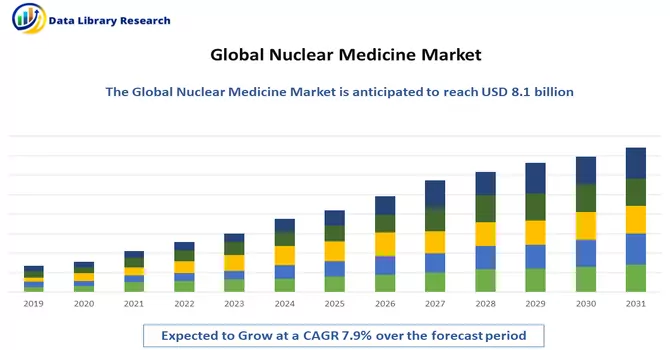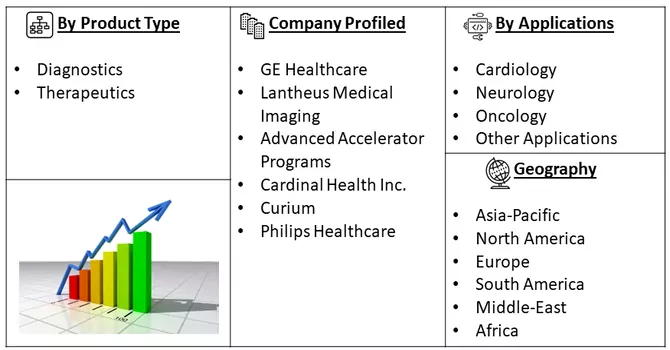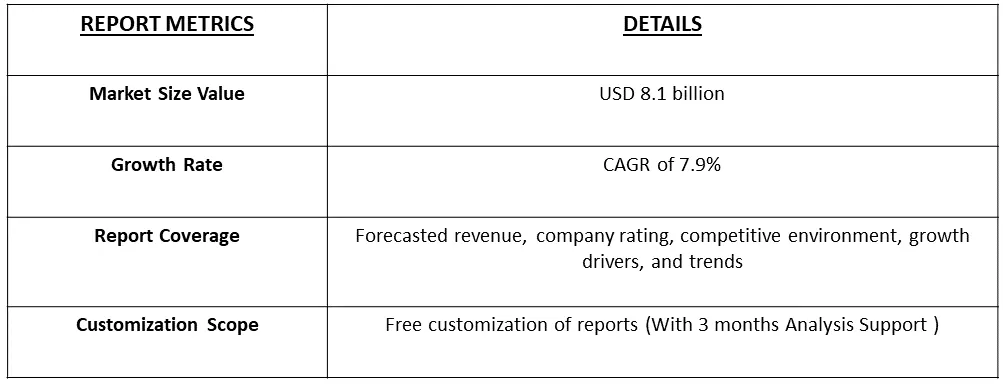The global nuclear medicine market size was valued at USD 8.1 billion in 2023 & is projected to a CAGR of 7.9% over the forecast period, 2024-2031.

Get Complete Analysis Of The Report - Download Free Sample PDF
Nuclear medicine stands as a medical discipline leveraging radioactive materials, termed radiopharmaceuticals or radiotracers, for the diagnosis and treatment of diverse medical conditions. This field employs minimal amounts of radioactive substances to generate images of internal body structures, offering non-invasive insights into organ and tissue function and structure. The nuclear medicine sector experiences notable growth due to the escalating prevalence of chronic illnesses, including cancer and cardiovascular disorders. The pivotal role of nuclear imaging techniques in the timely identification and management of these conditions propels market demand. Moreover, ongoing exploration into novel applications of nuclear medicine within neurology and cardiology widens the horizons of these technologies, presenting lucrative avenues for market expansion. This strategic diversification enhances the market's potential by addressing emerging needs in specialized medical domains. In essence, the continuous evolution of nuclear medicine aligns with the dynamic landscape of healthcare, positioning it as an integral player in advancing diagnostic and therapeutic capabilities.
The nuclear medicine market is witnessing notable trends, including the increasing integration of artificial intelligence (AI) for enhanced image analysis and interpretation, offering improved diagnostic accuracy. Moreover, there is a growing focus on theranostics, combining diagnostic and therapeutic applications in nuclear medicine, providing personalized treatment options. The shift towards hybrid imaging modalities, such as PET/CT and SPECT/CT, continues to gain momentum, offering comprehensive anatomical and functional information. Additionally, ongoing advancements in radiopharmaceutical development, with a focus on novel tracers and targeted therapies, contribute to expanding applications in oncology and other medical specialties. As the demand for precise and early disease detection rises, coupled with a greater emphasis on patient-centric care, these trends collectively shape the evolving landscape of the nuclear medicine market.
Market Segmentation: The Global Nuclear Medicine Market is Segmented by Product Type (Diagnostics (Single Photon Emission Computed Tomography (SPECT) and Positron Emission Tomography (PET)) and Therapeutics (Alpha Emitters, Beta Emitters, and Brachytherapy)), and by Applications (Cardiology, Neurology, Oncology, and Other Applications) and Geography (North America, Europe, Asia Pacific, Middle East, and Africa, and South America). The market size and forecasts are provided in terms of value (in USD million) for the above segments.

For Detailed Market Segmentation - Download Free Sample PDF
Market Drivers:
Increasing Incidence of Cancer and Chronic Diseases:
One of the primary drivers for the growth of the nuclear medicine market is the rising incidence of cancer and chronic diseases globally. Nuclear medicine techniques, including Positron Emission Tomography (PET) and Single Photon Emission Computed Tomography (SPECT), play a crucial role in the early detection, staging, and monitoring of various cancers. As the prevalence of cancer continues to escalate, the demand for nuclear medicine procedures for accurate diagnosis and effective treatment planning is on the rise. Additionally, nuclear medicine's application in the diagnosis and management of chronic conditions, such as cardiovascular diseases and neurological disorders, further propels market growth.
Advancements in Radiopharmaceuticals and Imaging Technologies:
The continuous advancements in radiopharmaceuticals and imaging technologies significantly drive the nuclear medicine market. Ongoing research and development efforts have led to the creation of innovative radiotracers and imaging agents that offer enhanced sensitivity and specificity in detecting various medical conditions. The development of novel positron-emitting radiopharmaceuticals for PET imaging and improvements in SPECT technologies contribute to the market's evolution. These advancements not only enhance diagnostic accuracy but also expand the scope of nuclear medicine applications, fostering increased adoption and market growth.
Market Restraints:
High Costs Associated with Nuclear Medicine Procedures:
A substantial challenge affecting the nuclear medicine market is the high cost associated with nuclear medicine procedures. The expenses involve the production and procurement of radiopharmaceuticals, specialized imaging equipment, and the implementation of safety measures. Additionally, the training required for healthcare professionals to operate and interpret nuclear imaging systems contributes to the overall cost. The financial burden is particularly significant for healthcare facilities and patients, potentially limiting the widespread adoption of nuclear medicine procedures. Addressing cost-related challenges and working towards cost-effective solutions will be crucial for overcoming this restraint and ensuring broader accessibility to nuclear medicine technologies.
Globally, the healthcare systems have grappled with substantial challenges imposed by the COVID-19 pandemic, necessitating significant adjustments such as the drastic reduction of both in- and outpatient services for various diseases. To curb the spread of the virus, stringent infection prevention and control measures have been implemented. A June 2022 study titled '2022 follow-up: impact of the COVID-19 pandemic on nuclear medicine departments in Europe' shed light on the widespread repercussions, indicating that the pandemic notably affected nuclear medicine education in a substantial majority of countries (84%). This impact was further delineated across different employment groups, with technologists, radio pharmacists, physicists, and physicians experiencing varying degrees of disruption, such as 78%, 59%, 67%, and 74%, respectively. The study's overarching findings underscored the significant global impact on nuclear medicine services. Additionally, the study revealed that 15% of respondents encountered instances of COVID-19 infections within their respective departments, underscoring the challenges faced by healthcare professionals in maintaining staff health during the ongoing pandemic.
Segmental Analysis:
Single Photon Emission Computed Tomography (SPECT) Segment is Expected to Witness Significant Growth Over the Forecast Period
Single Photon Emission Computed Tomography (SPECT) plays a pivotal role in the field of nuclear medicine, offering valuable insights into the diagnosis and treatment of various medical conditions. In nuclear medicine, SPECT is a non-invasive imaging technique that utilizes radiotracers, allowing physicians to observe and analyze the function and structure of organs and tissues within the body. The technique involves the detection of gamma-ray emissions from radiotracers injected into the patient, providing detailed three-dimensional images. SPECT has proven particularly effective in the diagnosis and management of cardiovascular diseases, neurological disorders, and certain types of cancer. It enables healthcare professionals to visualize blood flow, identify abnormalities, and assess organ function with a high degree of precision. For example, in cardiology, SPECT imaging is widely used to evaluate myocardial perfusion, aiding in the detection of coronary artery disease and guiding therapeutic interventions. The versatility of SPECT extends to its theranostic applications, where it combines diagnostic imaging with targeted radioisotope therapies. Radiotracers used in SPECT can be designed to deliver therapeutic radiation directly to specific cells, offering personalized treatment options for conditions like cancer and thyroid disorders. As technology advances, hybrid imaging modalities such as SPECT/CT (Single Photon Emission Computed Tomography/Computed Tomography) are becoming increasingly common. SPECT/CT combines the functional information provided by SPECT with anatomical details from CT scans, enhancing the accuracy of diagnoses and treatment planning. In conclusion, Single Photon Emission Computed Tomography plays a crucial role in nuclear medicine, contributing to the diagnosis, treatment, and management of various medical conditions. Its ability to provide functional information alongside anatomical details makes it a valuable tool in the hands of healthcare professionals striving for precision and personalized care in the ever-evolving landscape of medical imaging and therapeutics.
Oncology Segment is Expected to Witness Significant Growth Over the Forecast Period
The growth of this market segment can be attributed to several key factors. A significant contributor is the increasing prevalence of cancers that necessitate advanced diagnostics, particularly the use of PET/CT scans. The surge in funding allocated for the treatment of these disorders is anticipated to stimulate innovation and research, thereby fostering market growth. The rising global incidence of cancer has led to a heightened demand for radioisotopes in nuclear imaging for research purposes. Notably, recent studies have highlighted the expanding utility of gallium-68 labeled radiotracers, including their application in somatostatin receptor and prostate tracers for various cancer diagnoses. Studies, such as the one published by Richard P. Dittrich and team at Southend University Hospital NHS Foundation Trust, underscore the evolving role of gallium-68 in cancer imaging, extending to tumors like renal cell cancer, breast cancer, and prostate cancer. This research contributes to the increasing adoption of radioisotopes, particularly gallium-68, for enhanced cancer imaging. Additionally, radioisotopes play a crucial role in cancer treatment by allowing precise visualization of a tumor's location and contours within the body, surpassing the clarity provided by MRI scans. Isotopes like Copper-67, scandium-47, and actinium-225 are being studied for their therapeutic potential in delivering targeted radiation to cancer cells, indicating promising developments in cancer treatment methodologies. Furthermore, the market is poised for growth with the introduction of new products and services. Applied Molecular Therapies, for example, launched 177Lu(n.c.a.)-PSMA-Therapy in February 2022, a molecularly targeted radiopharmaceutical designed for treating prostate cancer. These advancements in technology and the continuous exploration of novel isotopes for both diagnostics and therapeutics are expected to propel the growth of the market in the foreseeable future.

Get Complete Analysis Of The Report - Download Free Sample PDF
The global nuclear medicine market is characterized by moderate fragmentation, with intense competition among market players. However, this competition is not solely driven by competitive pricing or product differentiation. Rather, major players in the pharmaceutical and biotechnology sectors are utilizing their substantial capital reserves to enter and expand within this market, thereby intensifying the competitive landscape. The competition extends beyond conventional market dynamics, with these industry giants leveraging their financial strength to make significant inroads. This trend underscores the strategic importance of capital investment and diversification as key factors influencing competition in the nuclear medicine market. Some of the market players are:
Recent Development:
1) In February 2022, SNMMI initiated a program enabling nuclear medicine facilities to qualify as designated and certified Centers of Excellence in Radiopharmaceutical Therapy. These centers are required to meet rigorous criteria encompassing regulations, training, qualification, experience, and performance. The emphasis on proper patient selection and outcomes from radiopharmaceutical therapy is integral to this initiative. This strategic program is poised to significantly contribute to the advancement of the US nuclear medicine market by elevating standards, ensuring excellence in radiopharmaceutical therapy, and fostering increased confidence among healthcare providers and patients.
2) In October 2023, Cyclopharm has secured FDA approval for its Technegas technology in nuclear medicine lung scans, specifically for diagnosing pulmonary embolism. Technegas employs technetium-99m-labeled carbon nanoparticles, generated and aerosolized by on-site Cyclomedica generators. Patients inhale the agent before undergoing lung imaging with a gamma camera. This regulatory green light enhances Cyclopharm's position in the U.S. market, providing an advanced diagnostic tool for pulmonary embolism and expanding its footprint in the nuclear medicine sector.
Q1. What was the Nuclear Medicine Market size in 2023?
As per Data Library Research the global nuclear medicine market size was valued at USD 8.1 billion in 2023.
Q2. At what CAGR is the market projected to grow within the forecast period?
Nuclear Medicine Market is projected to a CAGR of 7.9% over the forecast period.
Q3. Who are the key players in Nuclear Medicine Market?
Some key players operating in the market include
Q4. What segments are covered in the Nuclear Medicine Market Report?
By Product, By Application and Geography are the segments covered in the Nuclear Medicine Market Report.
Data Library Research are conducted by industry experts who offer insight on industry structure, market segmentations technology assessment and competitive landscape (CL), and penetration, as well as on emerging trends. Their analysis is based on primary interviews (~ 80%) and secondary research (~ 20%) as well as years of professional expertise in their respective industries. Adding to this, by analysing historical trends and current market positions, our analysts predict where the market will be headed for the next five years. Furthermore, the varying trends of segment & categories geographically presented are also studied and the estimated based on the primary & secondary research.
In this particular report from the supply side Data Library Research has conducted primary surveys (interviews) with the key level executives (VP, CEO’s, Marketing Director, Business Development Manager and SOFT) of the companies that active & prominent as well as the midsized organization
FIGURE 1: DLR RESEARH PROCESS

Extensive primary research was conducted to gain a deeper insight of the market and industry performance. The analysis is based on both primary and secondary research as well as years of professional expertise in the respective industries.
In addition to analysing current and historical trends, our analysts predict where the market is headed over the next five years.
It varies by segment for these categories geographically presented in the list of market tables. Speaking about this particular report we have conducted primary surveys (interviews) with the key level executives (VP, CEO’s, Marketing Director, Business Development Manager and many more) of the major players active in the market.
Secondary ResearchSecondary research was mainly used to collect and identify information useful for the extensive, technical, market-oriented, and Friend’s study of the Global Extra Neutral Alcohol. It was also used to obtain key information about major players, market classification and segmentation according to the industry trends, geographical markets, and developments related to the market and technology perspectives. For this study, analysts have gathered information from various credible sources, such as annual reports, sec filings, journals, white papers, SOFT presentations, and company web sites.
Market Size EstimationBoth, top-down and bottom-up approaches were used to estimate and validate the size of the Global market and to estimate the size of various other dependent submarkets in the overall Extra Neutral Alcohol. The key players in the market were identified through secondary research and their market contributions in the respective geographies were determined through primary and secondary research.
Forecast Model
